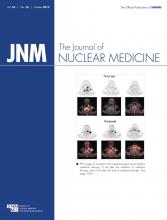TO THE EDITOR: Recently, Kramer-Marek et al. (1) published a very interesting study about the use of Affibody-based PET to monitor response to trastuzumab in a human xenograft breast carcinoma model overexpressing ErbB2. The study provides specific information on ErbB2 receptor expression upon treatment.
We completely agree with the authors that noninvasive detection of ErbB2 expression by novel imaging molecules such as ErbB2-specific Affibody molecules represents an important tool for in vivo identification of ErbB2-positive tumors and for significant information on disease dissemination, including brain metastasis. Moreover, in patients with ErbB2-negative primary breast tumors, this approach may enable identification of those with ErbB2-positive metastasis and thus relevant information in considering trastuzumab treatment.
Nevertheless, the authors’ claim that the N-[2-(4-18F-fluorobenzamido)ethyl]maleimide (18F-FBEM-HER2:342) Affibody (Affibody AB) may be used to determine whether trastuzumab treatment induces early ErbB2 downmodulation and a consequent decrease in efficacy of continued therapy should be carefully considered. The significant reduction of tracer uptake in human breast carcinoma BT474 xenografts after trastuzumab treatment could be related more to tumor size reduction than to ErbB2 downregulation. Indeed, although the authors observed a decrease in ErbB2 levels on the tumor cell membrane in some trastuzumab-treated mice, a large overlap of ErbB2 staining was also found between the trastuzumab-treated and control groups, suggesting that trastuzumab-induced ErbB2 internalization in the tumor cell is followed rapidly by receptor reexpression, with no global changes in ErbB2 levels. Consistent with this suggestion, a dramatic decrease of 111In-diethylenetriaminepentaacetic acid-trastuzumab and 125I-C6.5 diabody in trastuzumab-treated MDA MB-361 (2) and SKOV3 (3) xenografts, respectively, without ErbB2 downmodulation has been reported. Moreover, most immunohistochemical studies performed on ErbB2-positive tumors have revealed no changes in ErbB2 status after exposure to trastuzumab. In our pilot study of preoperative trastuzumab as monotherapy in patients with primary operable ErbB2-overexpressing breast tumors (4), the weekly administration of trastuzumab for 4 wk before surgery led to binding of ErbB2 receptors present on tumor cells but not to a change in ErbB2 expression levels; in all patients with residual tumor, the intense staining with biotinylated trastuzumab in the core biopsies was almost completely abrogated in the surgical specimens, whereas no change in ErbB2-positive staining was observed using monoclonal antibody CB11 directed against a synthetic peptide corresponding to the internal domain of ErbB2. In addition, no changes in ErbB2 receptor status were detected immunohistochemically in most patients with operable (5) or locally advanced (6) ErbB2-positive breast cancers after neoadjuvant exposure to trastuzumab in combination with chemotherapy. ErbB2-overexpressing tumors described as becoming negative on trastuzumab treatment appear to reflect the selection of ErbB2-negative cells rather than trastuzumab-induced ErbB2 downmodulation, as suggested by the loss of ErbB2 gene amplification detected by fluorescent in situ hybridization in 30%–40% of patients for whom enough residual tissue was available at the time of surgery to reassess ErbB2 after neoadjuvant therapy containing trastuzumab (7,8). If xenografts in which the authors found significantly downmodulated ErbB2 expression were only those with loss of HER2 amplification and Affibody uptake, then Affibody-based PET may actually provide a useful strategy for monitoring tumor response to trastuzumab.
However, it should also be noted that trastuzumab-induced inhibition of tumor vascularization has been documented in preclinical models (9), and the authors described a correlation between 18F-FBEM-HER2:342 Affibody uptake and high vessel count. Thus, impaired Affibody localization in xenografts may be due to decreased vascularization rather than to loss of ErbB2 expression.
Finally, tumor shrinkage induced by trastuzumab-containing therapy can sometimes be followed by an inflammatory reaction that masks any decrease in neoplastic mass. In those patients, a decrease in labeled Affibody uptake could be related to a reduced number of tumor cells instead of reduced ErbB2 levels, a hypothesis strongly supported by our recent report (10) of significant survival benefit in ErbB2-positive metastatic patients apparently nonresponsive on first-line trastuzumab treatment but in whom trastuzumab treatment was continued.
Overall, and in agreement with the authors, further intensive investigations are needed before one can conclude that this new noninvasive PET-based method represents a valuable strategy to evaluate changes in ErbB2 expression levels as an avenue to predicting response to trastuzumab.
Footnotes
Published online Aug. 23, 2012.
- © 2012 by the Society of Nuclear Medicine and Molecular Imaging, Inc.







